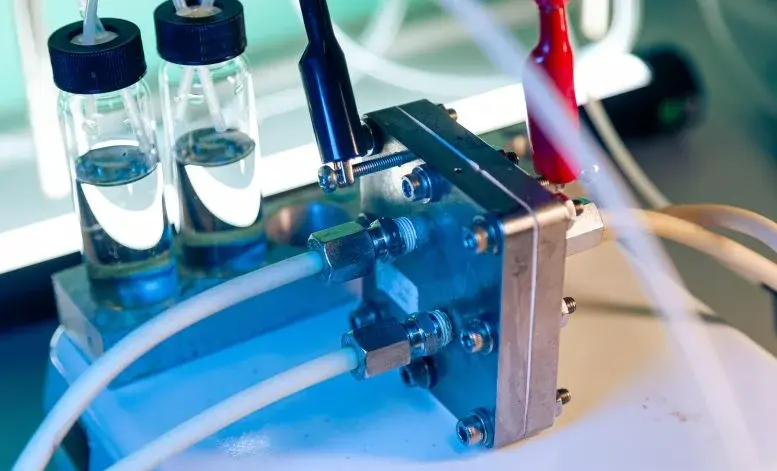A joint research study between IIT and its subsidiary BeDimensional has discovered a method using ruthenium particles in conjunction with a solar cell electrolysis system. What is needed for more efficient and cheaper production of green hydrogen? Apparently, it is a system for the electrolysis of small particles of ruthenium and water in solar cells. This solution was defined by a joint team including the Istituto Italiano di Tecnologia (Italian Institute of Technology, IIT) in Genoa and BeDimensional SpA (part of IIT).
A technology developed within the scope of joint laboratory activities and recently published in two high-impact journals (Nature Communication And Journal of the American Chemical Society) is based on a new family of electrocatalysts that can reduce the costs of environmentally friendly hydrogen production on an industrial scale.
Hydrogen is considered as a sustainable energy vector alternative to fossil fuels. But not all hydrogen is created equal when it comes to environmental impact. In fact, the main way to produce hydrogen today is through steam methane reforming, a fossil fuel-based process that releases carbon dioxide (CO).2) as a byproduct.
The hydrogen produced by this process is classified as “grey” (CO2 released into the atmosphere) or “blue” (CO2 captured and geologically preserved). To significantly reduce emissions to zero by 2050, these processes need to be replaced with more environmentally sustainable processes that deliver “green” (i.e. net-zero emissions) hydrogen. The cost of “green” hydrogen depends significantly on the energy efficiency of the plant (electrolyzer) that splits water molecules into hydrogen and oxygen.
Technological innovations in hydrogen production
Researchers from the joint team of this discovery have developed a new method that guarantees higher efficiency than known methods in converting electrical energy (displacement energy used to split water molecules) into chemical energy stored in the hydrogen molecules produced. . The team developed the catalyst concept and used renewable energy sources, such as electricity produced by solar panels.
“In our research, we have shown how the efficiency of a reliable, well-designed technology can be maximized despite an initial investment slightly higher than that required for a standard electrolyzer. This is because we use a precious metal such as ruthenium,” commented Yong Tsuo from the nanochemistry group at IIT Genoa and Michele Ferri.
The researchers used nanoparticles of ruthenium, a noble metal similar to platinum in its chemical behavior but much cheaper. Ruthenium nanoparticles serve as the active phase of the cathode of the electrolyzer, which helps improve the efficiency of the electrolyzer as a whole.
“We carried out electrochemical analyzes and tests under industrially suitable conditions, which allowed us to evaluate the catalytic activity of our materials. In addition, theoretical modeling allowed us to understand the catalytic behavior of ruthenium nanoparticles at the molecular level; in other words, the mechanism of dissociation on the surfaces of water,” explains BeDimensional, which participated in the discovery. Sebastiano Bellani and Marilena Zappia. “By combining data from our experiments with additional process parameters, we conducted a feasibility analysis demonstrating the competitiveness of this technology compared to state-of-the-art electrolyzers.”
Economic efficiency of new technology
Ruthenium is a precious metal obtained in small quantities as a byproduct of platinum mining (30 tonnes per year compared to the annual production of 200 tonnes of platinum), but at a lower price ($18.5 per gram compared to the annual production of 200 tonnes of platinum). The new technology involves the use of only 40 mg of ruthenium per kilowatt; which is in stark contrast to the widespread use of platinum (up to 1 gram per kilowatt) and iridium (1 to 2.5 grams per kilowatt, iridium priced at about 2.5 grams). $150). per gram), which characterizes proton exchange membrane electrolyzers.
Using ruthenium, researchers at IIT and BeDimensional have improved the efficiency of alkaline electrolyzers, a technology that has been used for decades for its strength and durability. For example, this technology was used in the Apollo 11 capsule that took humanity to the moon in 1969. The new family of ruthenium-based cathodes developed for alkaline electrolyzers is highly efficient and has a long service life, thus having the capacity to reduce the cost of green hydrogen production.
“In the future, we plan to apply this and other technologies, such as nanostructured catalysts based on stable two-dimensional materials, in advanced electrolyzers powered by electricity from renewable sources, including electricity generated by photovoltaic panels,” the researchers wrote.













